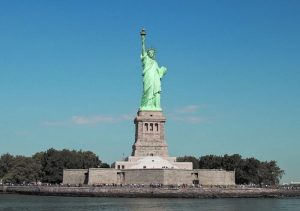July 1, 2023
Ellis Island: “Island of Hope; Island of Tears”
 By Mary Schricker Gemberling
By Mary Schricker Gemberling
On a recent trip to New York City, Gary and I visited the Statue of Liberty and Ellis Island. Although we had seen both from a boat, we had never had an up-close look. After a subway ride from our hotel in Times Square, we boarded the ferry that would take us by the Statue of Liberty to the Ellis Island National Museum of Immigration.
Ellis Island is a historical site that opened in 1892 as an immigration station, a purpose it served for more than 60 years until it closed in 1954.
Located at the mouth of the Hudson River between New York and New Jersey, Ellis Island saw millions of newly arrived immigrants pass through its doors. In fact, it has been estimated that close to 40 percent of all current US citizens can trace at least one of their ancestors to Ellis Island.
In the 1920s the number and nationality of immigrants allowed in the United States were limited, ending the era of mass immigration into New York City. Ellis Island opened to the public as a park in 1976.
The museum documents the immigrant experience at Ellis Island and the general history of immigration. Through an audio tour we were able to follow the immigration process: initial questioning in the Registry Room, medical inspections, and temporary detention for some. Detained immigrants could plead their case to the Special Inquiry in the Hearing Room. Most were allowed through. In the Registry Room or ‘Great Hall, immigrants underwent legal and medical examinations. The doctors watched for a limp, labored breathing or other signs of frailty. Inspectors asked immigrants their name, hometowns, occupation, destination, and amount of money they carried….up to 31 questions in all. Those allowed to pass continued downstairs, exchanged money, bought provisions, and perhaps rail tickets. A third or so stayed in New York City. About 20 percent were held for further legal or medical examinations. Only about 2 percent were denied entry.
The Ellis Island National Museum is a remarkable attraction and a living tribute to the millions of immigrants that traveled at great lengths from all over the world to settle and prosper in the United States. The museum contains a vast collection of artifacts, personal effects, and exhibits that reveal the countless stories of the trials and triumphs of the immigrants who traveled to America. Many told of the fears they felt: fear of the unknown, fear of being sent to the hospital, fear of deportation, and the worst one….fear of being separated from their families.

Other exhibits in the museum include:
- Journeys: New Eras of Immigration, traces the immigration story beyond Ellis Island years to today.
- The Citizenship Gallery highlights the changing meanings and requirements of US Citizenship.
- American Family Immigration History Center maintains a database of immigrant ships’ manifests from the Port of New York in the years 1820-1957. Here visitors can search the records for a family member who they think entered the country through Ellis Island. It’s a very user-friendly system with personnel to help.
- Journeys; The Peopling of America 1550-1890 which tells the story of immigration to the United States before the federal government opened Ellis Island.
It was a humbling experience to trace the steps of people pursuing new lives in a new land. Being an immigrant wasn’t easy. The journey through Ellis Island was intimidating and often frightening. But despite their fears and doubts, millions of people made the trip and built a better future for themselves and their families. Without their bravery, we wouldn’t be the country we are today!
There are only two lasting bequests we can give
our children – one is roots and the other, wings.
Mary, a former educator and Seniors Real Estate Specialist, is the author of four books: The West End Kid, Labor of Love, Hotel Blackhawk; A Century of Elegance, Ebenezer Methodist Church; 150 years of Resiliency.


